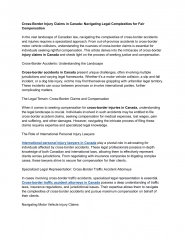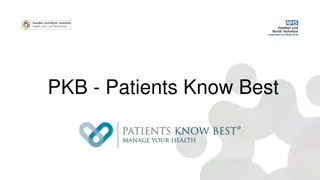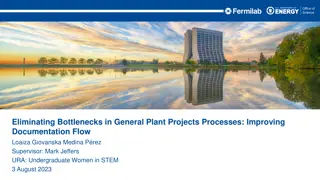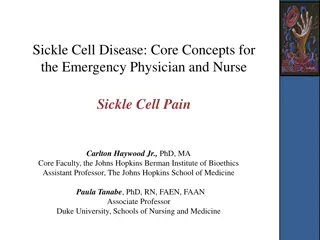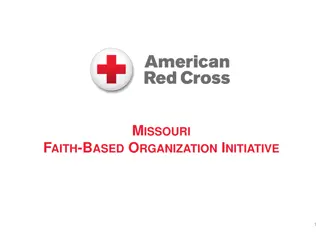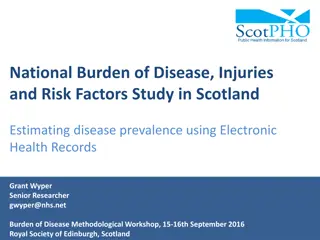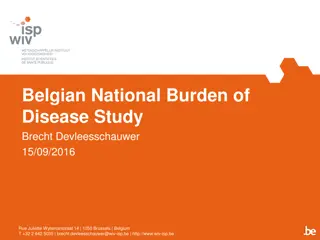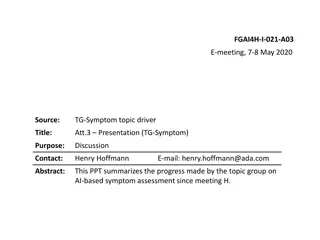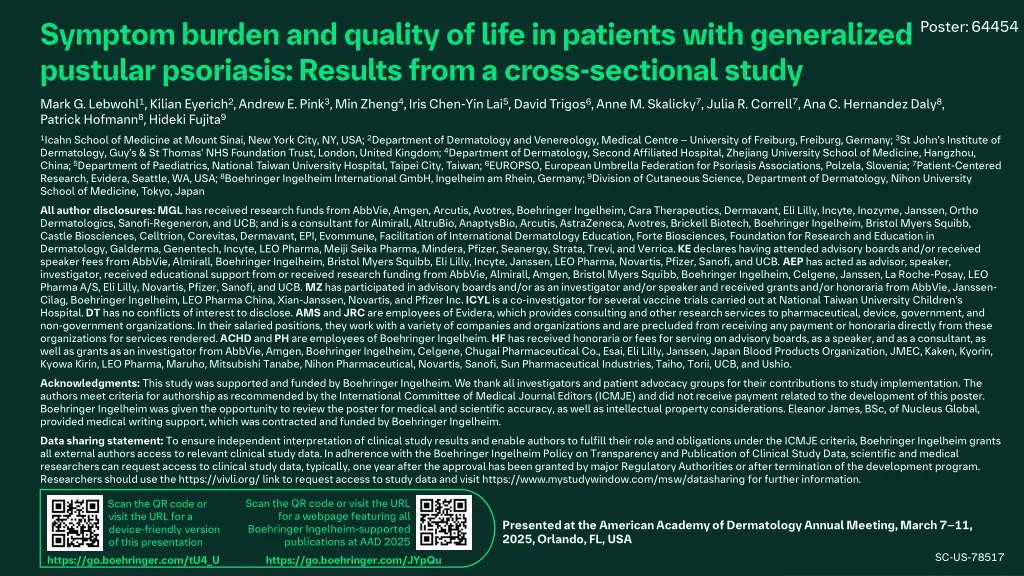
Symptom Burden and Quality of Life in Patients with Generalized Pustular Psoriasis
This cross-sectional study explores the symptom burden and quality of life in patients with generalized pustular psoriasis. Findings highlight the impact of the condition on patients' well-being, providing valuable insights for further research and patient care.
Download Presentation

Please find below an Image/Link to download the presentation.
The content on the website is provided AS IS for your information and personal use only. It may not be sold, licensed, or shared on other websites without obtaining consent from the author. If you encounter any issues during the download, it is possible that the publisher has removed the file from their server.
You are allowed to download the files provided on this website for personal or commercial use, subject to the condition that they are used lawfully. All files are the property of their respective owners.
The content on the website is provided AS IS for your information and personal use only. It may not be sold, licensed, or shared on other websites without obtaining consent from the author.
E N D
Presentation Transcript
Symptom burden and quality of life in patients with generalized pustular psoriasis: Results from a cross-sectional study Mark G. Lebwohl1, Kilian Eyerich2, Andrew E. Pink3, Min Zheng4, Iris Chen-Yin Lai5, David Trigos6, Anne M. Skalicky7, Julia R. Correll7, Ana C. Hernandez Daly8, Patrick Hofmann8, Hideki Fujita9 Poster: 64454 1Icahn School of Medicine at Mount Sinai, New York City, NY, USA; 2Department of Dermatology and Venereology, Medical Centre University of Freiburg, Freiburg, Germany; 3St John s Institute of Dermatology, Guy s & St Thomas' NHS Foundation Trust, London, United Kingdom; 4Department of Dermatology, Second Affiliated Hospital, Zhejiang University School of Medicine, Hangzhou, China; 5Department of Paediatrics, National Taiwan University Hospital, Taipei City, Taiwan; 6EUROPSO, European Umbrella Federation for Psoriasis Associations, Polzela, Slovenia; 7Patient-Centered Research, Evidera, Seattle, WA, USA; 8Boehringer Ingelheim International GmbH, Ingelheim am Rhein, Germany; 9Division of Cutaneous Science, Department of Dermatology, Nihon University School of Medicine, Tokyo, Japan All author disclosures: MGL has received research funds from AbbVie, Amgen, Arcutis, Avotres, Boehringer Ingelheim, Cara Therapeutics, Dermavant, Eli Lilly, Incyte, Inozyme, Janssen, Ortho Dermatologics, Sanofi-Regeneron, and UCB; and is a consultant for Almirall, AltruBio, AnaptysBio, Arcutis, AstraZeneca, Avotres, Brickell Biotech, Boehringer Ingelheim, Bristol Myers Squibb, Castle Biosciences, Celltrion, Corevitas, Dermavant, EPI, Evommune, Facilitation of International Dermatology Education, Forte Biosciences, Foundation for Research and Education in Dermatology, Galderma, Genentech, Incyte, LEO Pharma, Meiji Seika Pharma, Mindera, Pfizer, Seanergy, Strata, Trevi, and Verrica. KE declares having attended advisory boards and/or received speaker fees from AbbVie, Almirall, Boehringer Ingelheim, Bristol Myers Squibb, Eli Lilly, Incyte, Janssen, LEO Pharma, Novartis, Pfizer, Sanofi, and UCB. AEP has acted as advisor, speaker, investigator, received educational support from or received research funding from AbbVie, Almirall, Amgen, Bristol Myers Squibb, Boehringer Ingelheim, Celgene, Janssen, La Roche-Posay, LEO Pharma A/S, Eli Lilly, Novartis, Pfizer, Sanofi, and UCB. MZ has participated in advisory boards and/or as an investigator and/or speaker and received grants and/or honoraria from AbbVie, Janssen- Cilag, Boehringer Ingelheim, LEO Pharma China, Xian-Janssen, Novartis, and Pfizer Inc. ICYL is a co-investigator for several vaccine trials carried out at National Taiwan University Children s Hospital. DT has no conflicts of interest to disclose. AMS and JRC are employees of Evidera, which provides consulting and other research services to pharmaceutical, device, government, and non-government organizations. In their salaried positions, they work with a variety of companies and organizations and are precluded from receiving any payment or honoraria directly from these organizations for services rendered. ACHD and PH are employees of Boehringer Ingelheim. HF has received honoraria or fees for serving on advisory boards, as a speaker, and as a consultant, as well as grants as an investigator from AbbVie, Amgen, Boehringer Ingelheim, Celgene, Chugai Pharmaceutical Co., Esai, Eli Lilly, Janssen, Japan Blood Products Organization, JMEC, Kaken, Kyorin, Kyowa Kirin, LEO Pharma, Maruho, Mitsubishi Tanabe, Nihon Pharmaceutical, Novartis, Sanofi, Sun Pharmaceutical Industries, Taiho, Torii, UCB, and Ushio. Acknowledgments: This study was supported and funded by Boehringer Ingelheim. We thank all investigators and patient advocacy groups for their contributions to study implementation. The authors meet criteria for authorship as recommended by the International Committee of Medical Journal Editors (ICMJE) and did not receive payment related to the development of this poster. Boehringer Ingelheim was given the opportunity to review the poster for medical and scientific accuracy, as well as intellectual property considerations. Eleanor James, BSc, of Nucleus Global, provided medical writing support, which was contracted and funded by Boehringer Ingelheim. Data sharing statement: To ensure independent interpretation of clinical study results and enable authors to fulfill their role and obligations under the ICMJE criteria, Boehringer Ingelheim grants all external authors access to relevant clinical study data. In adherence with the Boehringer Ingelheim Policy on Transparency and Publication of Clinical Study Data, scientific and medical researchers can request access to clinical study data, typically, one year after the approval has been granted by major Regulatory Authorities or after termination of the development program. Researchers should use the https://vivli.org/ link to request access to study data and visit https://www.mystudywindow.com/msw/datasharing for further information. Scan the QR code or visit the URL for a webpage featuring all Boehringer Ingelheim-supported publications at AAD 2025 https://go.boehringer.com/JYpQu Scan the QR code or visit the URL for a device-friendly version of this presentation Presented at the American Academy of Dermatology Annual Meeting, March 7 11, 2025, Orlando, FL, USA SC-US-78517 https://go.boehringer.com/tU4_U
Introduction Methods Generalized pustular psoriasis (GPP) is a rare, chronic, systemic inflammatory disease with a heterogeneous course1,2 The clinical course of GPP is characterized by chronic symptoms and periods of flaring (rapidly disseminating painful skin manifestations often accompanied by systemic symptoms, such as pain, fever, and fatigue)3,4 GPP is associated with a considerable clinical burden, which can greatly affect a patient s quality of life (QoL)4,5 However, due to the rarity of GPP, understanding of the clinical and humanistic burden is limited2,6 This sub-analysis of a cross-sectional study evaluated symptom burden and QoL in patients with GPP Study design This sub-analysis of a cross-sectional, non-interventional study involved adult patients with GPP from four countries: China, Japan, the UK, and USA Participants were recruited by a combination of patient advocacy groups, recruitment vendors, and clinical sites Data were collected via a web-based surveyandsemi-structured, qualitative telephone interviews All participants who were eligible for the surveyhad the opportunity to opt into a telephone interview Eligibility and enrollment Individuals >18 years of age who received a diagnosis of GPP 12 months prior to screening Have experienced 1 flare within the past 12 months Aim To characterize patient-reported symptom burden in adults with GPP, and understand the impact of GPP on QoL during and between flares GPP, generalized pustular psoriasis; QoL, quality of life. 1. Rivera-D az R, et al. Dermatol Ther (Heidelb). 2023;13:673 88; 2. Puig L, et al. J Eur Acad Dermatol Venereol. 2023;37:37 52; 3. Choon SE, et al. Am J Clin Dermatol. 2022;23(Suppl 1):21 9; 4. Gooderham M, et al. Expert Rev Clin Immunol. 2019;15:907 19; 5. Reisner DV, et al. Am J Clin Dermatol. 2022;23(Suppl 1):65 71; 6. Kharawala S, et al. Expert Rev Clin Immunol. 2020;16:239 52. 2
Results: Patient-reported GPP disease status varied Demographics and baseline characteristics GPP disease status 21 patients with GPP completed the survey Unable to recall date of last flare* 3 (14.3%) Participants had been diagnosed with GPP an average of 16.1 (standard deviation [SD]: 15.0) years ago 57.1% (n=12) female Mean age ( SD): 40.7 (12.0) years Flared >3 months prior 10 Currently experiencing a flare 4 (48.0%) (19.0%) 4 (19.0%) Patients, n US Japan UK China Total Flared 1 3 months prior Survey 2 5 5 9 21 Interview 1 2 1 5 9 *One patient reported never having a flare: On the survey, this patient had earlier reported having one flare in the past 12 months, then when specifically asked how recent the last flare was, they reported never having a flare. Given the rest of this patient s responses, it appears that this response was an error, and they had actually experienced one flare in the past 12 months as originally reported in the survey. This patient did not complete an interview. GPP, generalized pustular psoriasis; SD, standard deviation. 3
Results: GPP had a considerable impact on patient QoL QoL* Mean Dermatology Life Quality Index (DLQI) scores for those who were currently experiencing a flare and those who flared 1 3 months prior were similar When rating the worst severity of GPP-related pain in the past 24 hours, patients who flared 1 3 months prior had a similar mean Pain Numerical Rating Scale (NRS) score to those currently experiencing a flare A DLQI score of 6 10 indicates a moderate effect, and a score of 11 20 indicates a very large effect on a person s life1 Currently experiencing a flare (n=4) Flared 1 3 months prior (n=4) Flared >3 months prior (n=10) DLQI 11.8 (8.8) 11.5 (10.2) 9.2 (11.2) Very large effect Very large effect Moderate effect Mean score ( SD) Pain NRS Mean score ( SD) 5.0 (3.6) 5.7 (4.5) 2.7 (3.4) A Pain NRS score of 1 3 indicates mild pain, and a score of 4 6 indicates moderate pain2 Moderate pain Moderate pain Mild pain *DLQI scores measured on a scale of 0 30; Pain NRS scores measured on a scale of 0 10; higher scores indicate a more severe (worse) impact. DLQI, Dermatology Life Quality Index; NRS, Numerical Rating Scale; QoL, quality of life; SD, standard deviation. 1. Hongbo Y, et al. J Invest Dermatol. 2005;125:659 64; 2. Breivik H, et al. Br J Anaesth. 2008;101:17 24. 4
Results: Many GPP patients reported chronic symptoms Clinical burden Most common symptoms experienced in the past 12 months* Symptom, n (%) Overall, 9/21 patients (42.9%) experienced GPP symptoms every day In the past 12 months, itching, pustules, and redness were the most common skin symptoms (14/21; 66.7% for each), skin pain was the most reported pain-type symptom (10/21; 47.6%), and fatigue (13/21; 61.9%) was the most reported systemic symptom After the peak of the flare, 33 43% of patients had persistent cutaneous symptoms, discomfort, and fatigue Of patients reporting emotional impact (n=8), GPP-related depression and stress were reported by 6/8 (75.0%) and 3/8 (37.5%) patients, respectively N=21 Skin symptoms Itching 14 (66.7) I could not get out of bed, and my whole body hurt - GPP patient, China Pustules 14 (66.7) Redness 14 (66.7) Dryness/dry skin 13 (61.9) Peeling skin 13 (61.9) Inflammation 12 (57.1) Swelling 10 (47.6) my appearance was very stressful to me - GPP patient, Japan Pain-type symptoms Pain (skin) 10 (47.6) Systemic symptoms Fatigue 13 (61.9) Not feeling well/discomfort 13 (61.9) Fever, shivering 11 (52.4) Other symptoms Mental discomfort or irritability 14 (66.7) Conclusions In this cross-sectional, multinational, non-interventional study, patients with GPP reported a considerable symptom burden and impact on QoL Although larger effects were seen in patients who had flared more recently, many patients reported chronic symptoms and QoL burden in the past 12 months, including after the peak of a flare and irrespective of the status of their disease *Reported in 10 patients. GPP, generalized pustular psoriasis; QoL, quality of life. 5


